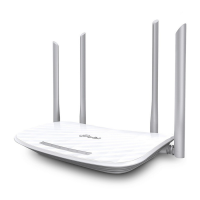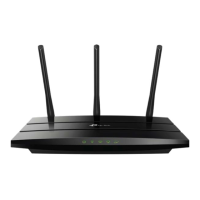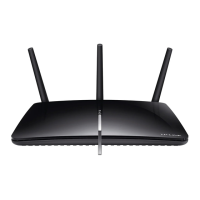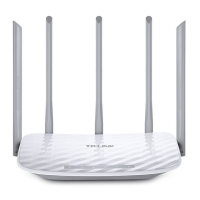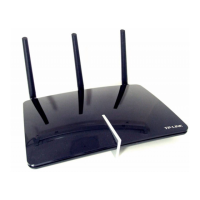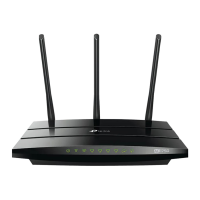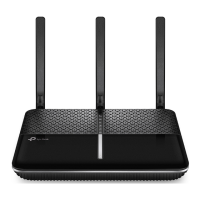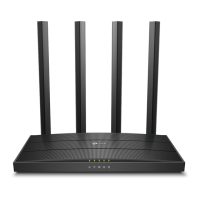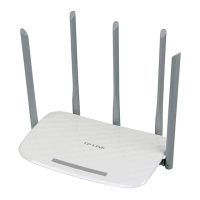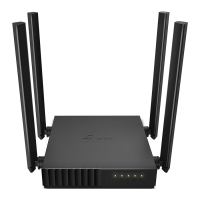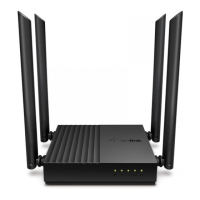Do you have a question about the TP-Link Archer GE800 and is the answer not in the manual?
Explains the router's Wi-Fi 7 capabilities, performance, and ease of use.
Details the buttons and indicators located on the front of the router.
Identifies the ports and connectors on the back and side of the router.
Provides guidance on optimal placement of the router for best performance and safety.
Step-by-step instructions for connecting the router to the internet and your computer.
Outlines the steps to access and log into the router's web management interface.
Guides users through an automated process for configuring internet connection settings.
Explains how to use the mobile app for a quick internet setup.
Provides instructions for manually configuring various internet connection types (Dynamic IP, Static IP, PPPoE).
Instructions for configuring the router to function as an access point.
Details the process for setting up an internet connection using IPv6 protocols.
How to configure firewall rules for IPv6 network protection.
Steps for creating a TP-Link ID to manage devices and access cloud services.
Instructions for changing email address and password associated with a TP-Link ID.
How to add or remove user TP-Link IDs to manage the router.
Guide to using the TP-Link Tether app for remote router management.
Explains how the Network Map visually displays device connectivity and general network settings.
How to view devices forming a mesh network with the router.
How to view connected client devices and manage their speeds or block them.
Customizing SSIDs, passwords, and security options for wireless networks.
How to schedule the automatic turn-on/off of wireless networks.
Guide to establishing wireless connections using Wi-Fi Protected Setup (WPS).
Configuration of advanced wireless parameters like WMM, AP Isolation, and channel settings.
Steps to set up a separate Wi-Fi network for guests, including customization options.
Configuring guest permissions, such as allowing guests to see each other or access the local network.
Setting up a separate wireless network for managing IoT devices securely.
Instructions for accessing files stored on USB devices connected to the router from a local network.
Guide to accessing USB storage devices from outside the local area network.
How to customize sharing addresses, content, and authentication for USB devices.
Enabling and using the Media Sharing feature to stream content from USB devices.
Setting up Time Machine backups for Mac computers to a USB storage device.
Scanning the network for performance analysis and security optimization.
Setting restrictions on internet access for family members, including content filtering and time limits.
Prioritizing network traffic for specific devices or applications to ensure smooth performance.
Information on accessing advanced HomeShield features through the Tether app.
Instructions for adding another TP-Link router to create an EasyMesh network.
Steps to connect a range extender to the main router for EasyMesh functionality.
How to view and manage devices within the EasyMesh network.
Configuring the SPI Firewall to protect the router from online threats.
Blocking or allowing specific devices to access the network using MAC address filtering.
Binding IP addresses to MAC addresses to prevent ARP spoofing and related attacks.
Configuring Application Layer Gateway (ALG) settings for specific protocols.
Isolating IoT devices to protect the network from potential security threats.
Configuring port forwarding rules to allow external access to internal services.
Dynamically opening ports based on triggering port activity for applications.
Configuring a device as a DMZ host for unrestricted internet access.
Enabling Universal Plug and Play for automatic port opening and seamless device connectivity.
Step-by-step guide to setting up an OpenVPN server for secure remote access.
Instructions for configuring a PPTP VPN server for remote network access.
Guide to setting up an L2TP/IPSec VPN server for secure remote connections.
Configuring a WireGuard VPN server for fast and secure remote access.
Instructions for configuring the router as a VPN client to access remote VPN servers.
Modifying internet port settings and connection types as needed.
Adjusting the router's LAN IP address and subnet mask for network configuration.
Combining multiple ports to create a higher-bandwidth wired connection.
Enabling flow control to manage network congestion and prevent packet loss.
Setting up the router to support IPTV services, including IGMP proxy and VLAN configuration.
Configuring DHCP server settings, including IP address pools and reservations.
Configuring Dynamic DNS service for remote access using a domain name.
Manually configuring routing table entries for specific network destinations.
Instructions for updating the router's firmware via auto, online, or local methods.
How to back up and restore router configuration settings, and factory reset options.
Procedure for changing the router's web management login password.
Configuring password recovery options using an email account.
Limiting router access based on MAC addresses for local network management.
Configuring remote access to the router via WAN IP address and port.
Saving and sending system logs for troubleshooting and monitoring.
Using Ping and Traceroute tools to diagnose network connectivity issues.
Configuring the router's system time, time zone, and display language.
Scheduling regular automatic reboots to maintain router performance.
Configuring LED behavior, including enabling Night Mode for automatic shutoff.
Overview of router parameters, RGB effects, network traffic, and USB devices in the Game Panel.
Using QoS, Game Server Acceleration, and Gear Acceleration to improve gaming performance.
Setting up port forwarding rules for popular online games to optimize connections.
Displaying statistics for recently played games.
Testing and displaying real-time ping for game servers without affecting acceleration.
Testing connectivity between the router and game servers using Ping or Traceroute.
Explains the router's Wi-Fi 7 capabilities, performance, and ease of use.
Details the buttons and indicators located on the front of the router.
Identifies the ports and connectors on the back and side of the router.
Provides guidance on optimal placement of the router for best performance and safety.
Step-by-step instructions for connecting the router to the internet and your computer.
Outlines the steps to access and log into the router's web management interface.
Guides users through an automated process for configuring internet connection settings.
Explains how to use the mobile app for a quick internet setup.
Provides instructions for manually configuring various internet connection types (Dynamic IP, Static IP, PPPoE).
Instructions for configuring the router to function as an access point.
Details the process for setting up an internet connection using IPv6 protocols.
How to configure firewall rules for IPv6 network protection.
Steps for creating a TP-Link ID to manage devices and access cloud services.
Instructions for changing email address and password associated with a TP-Link ID.
How to add or remove user TP-Link IDs to manage the router.
Guide to using the TP-Link Tether app for remote router management.
Explains how the Network Map visually displays device connectivity and general network settings.
How to view devices forming a mesh network with the router.
How to view connected client devices and manage their speeds or block them.
Customizing SSIDs, passwords, and security options for wireless networks.
How to schedule the automatic turn-on/off of wireless networks.
Guide to establishing wireless connections using Wi-Fi Protected Setup (WPS).
Configuration of advanced wireless parameters like WMM, AP Isolation, and channel settings.
Steps to set up a separate Wi-Fi network for guests, including customization options.
Configuring guest permissions, such as allowing guests to see each other or access the local network.
Setting up a separate wireless network for managing IoT devices securely.
Instructions for accessing files stored on USB devices connected to the router from a local network.
Guide to accessing USB storage devices from outside the local area network.
How to customize sharing addresses, content, and authentication for USB devices.
Enabling and using the Media Sharing feature to stream content from USB devices.
Setting up Time Machine backups for Mac computers to a USB storage device.
Scanning the network for performance analysis and security optimization.
Setting restrictions on internet access for family members, including content filtering and time limits.
Prioritizing network traffic for specific devices or applications to ensure smooth performance.
Information on accessing advanced HomeShield features through the Tether app.
Instructions for adding another TP-Link router to create an EasyMesh network.
Steps to connect a range extender to the main router for EasyMesh functionality.
How to view and manage devices within the EasyMesh network.
Configuring the SPI Firewall to protect the router from online threats.
Blocking or allowing specific devices to access the network using MAC address filtering.
Binding IP addresses to MAC addresses to prevent ARP spoofing and related attacks.
Configuring Application Layer Gateway (ALG) settings for specific protocols.
Isolating IoT devices to protect the network from potential security threats.
Configuring port forwarding rules to allow external access to internal services.
Dynamically opening ports based on triggering port activity for applications.
Configuring a device as a DMZ host for unrestricted internet access.
Enabling Universal Plug and Play for automatic port opening and seamless device connectivity.
Step-by-step guide to setting up an OpenVPN server for secure remote access.
Instructions for configuring a PPTP VPN server for remote network access.
Guide to setting up an L2TP/IPSec VPN server for secure remote connections.
Configuring a WireGuard VPN server for fast and secure remote access.
Instructions for configuring the router as a VPN client to access remote VPN servers.
Modifying internet port settings and connection types as needed.
Adjusting the router's LAN IP address and subnet mask for network configuration.
Combining multiple ports to create a higher-bandwidth wired connection.
Enabling flow control to manage network congestion and prevent packet loss.
Setting up the router to support IPTV services, including IGMP proxy and VLAN configuration.
Configuring DHCP server settings, including IP address pools and reservations.
Configuring Dynamic DNS service for remote access using a domain name.
Manually configuring routing table entries for specific network destinations.
Instructions for updating the router's firmware via auto, online, or local methods.
How to back up and restore router configuration settings, and factory reset options.
Procedure for changing the router's web management login password.
Configuring password recovery options using an email account.
Limiting router access based on MAC addresses for local network management.
Configuring remote access to the router via WAN IP address and port.
Saving and sending system logs for troubleshooting and monitoring.
Using Ping and Traceroute tools to diagnose network connectivity issues.
Configuring the router's system time, time zone, and display language.
Scheduling regular automatic reboots to maintain router performance.
Configuring LED behavior, including enabling Night Mode for automatic shutoff.
Overview of router parameters, RGB effects, network traffic, and USB devices in the Game Panel.
Using QoS, Game Server Acceleration, and Gear Acceleration to improve gaming performance.
Setting up port forwarding rules for popular online games to optimize connections.
Displaying statistics for recently played games.
Testing and displaying real-time ping for game servers without affecting acceleration.
Testing connectivity between the router and game servers using Ping or Traceroute.
| Wi-Fi band | Tri-band (2.4 GHz / 5 GHz / 6 GHz) |
|---|---|
| Wi-Fi standards | Wi-Fi 7 (802.11be) |
| WLAN data transfer rate (first band) | 1376 Mbit/s |
| WLAN data transfer rate (third band) | 11520 Mbit/s |
| WLAN data transfer rate (second band) | 5760 Mbit/s |
| DMZ support | Yes |
| Security algorithms | WPA, WPA-Enterprise, WPA2, WPA2-Enterprise, WPA3 |
| Networking standards | IEEE 802.11a, IEEE 802.11ac, IEEE 802.11ax, IEEE 802.11be, IEEE 802.11n, IEEE 802.1x |
| Ethernet LAN data rates | 10, 100, 1000, 1200, 10000 Mbit/s |
| Ethernet LAN interface type | 10 Gigabit Ethernet |
| USB 2.0 ports quantity | USB 2.0 ports have a data transmission speed of 480 Mbps, and are backwards compatible with USB 1.1 ports. You can connect all kinds of peripheral devices to them. |
| Ethernet LAN (RJ-45) ports | 1 |
| DSL WAN | No |
| WAN connection type | RJ-45 |
| 3G/4G USB modem compatibility | - |
| Power source type | USB |
| Product type | Tabletop router |
| Operating temperature (T-T) | 0 - 40 °C |
| Operating relative humidity (H-H) | 10 - 90 % |
| Depth | 207 mm |
|---|---|
| Width | 292 mm |
| Height | 224 mm |

